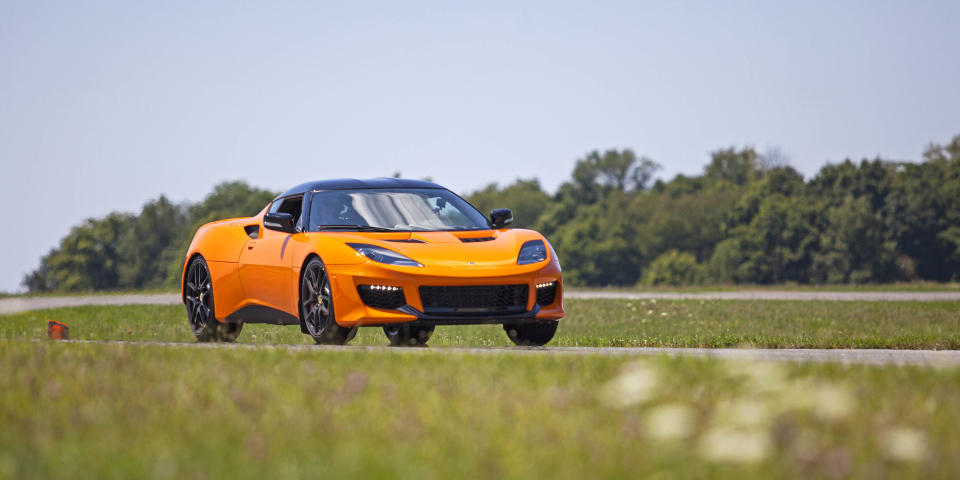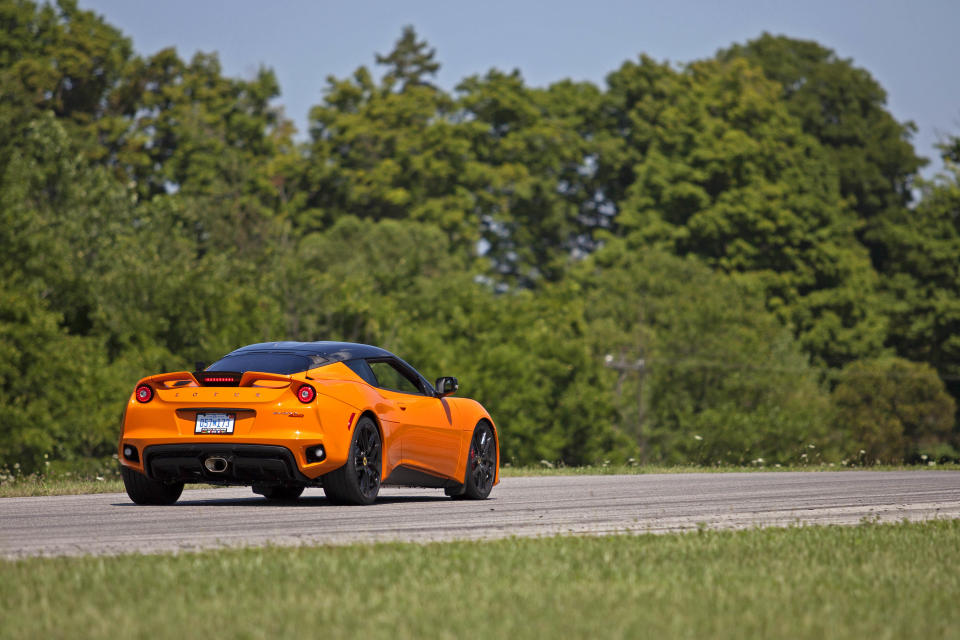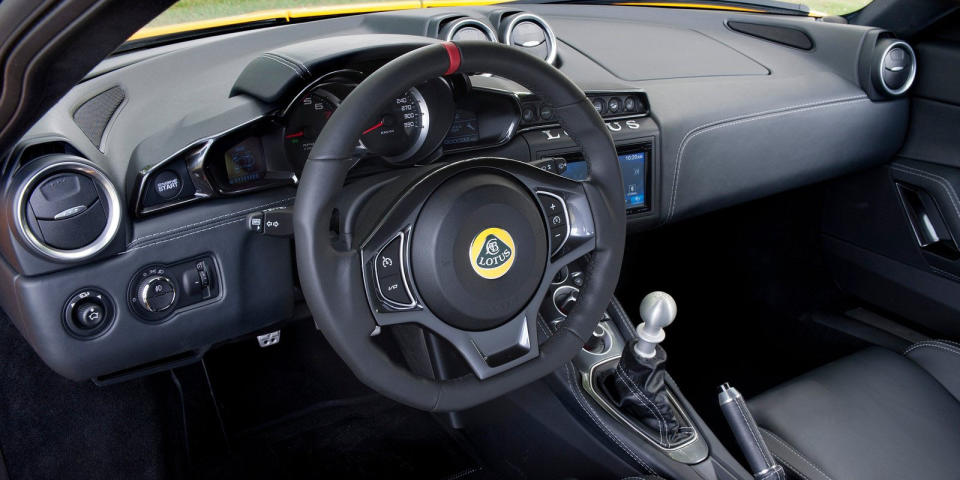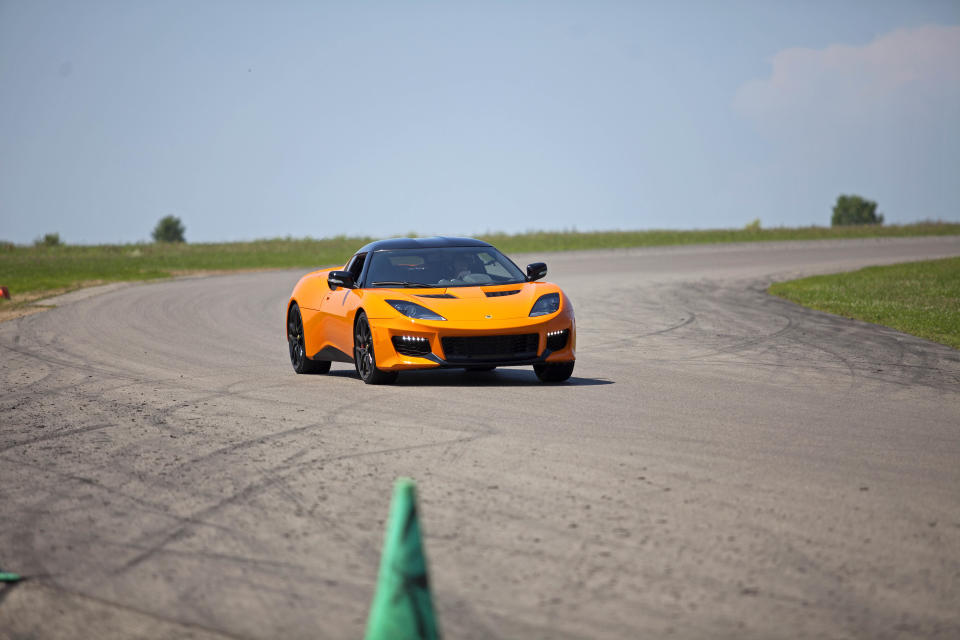The Lotus Evora 400 Is the Truth

He was a local to Gingerman Raceway, born and raised in western Michigan near the lake. He knew the track and he knew the surface. But he underestimated the speed of the new Lotus Evora 400. Perhaps he mistook it for the previous model, the 345-horsepower Evora S that took the win against the 991-generation Porsche 911 Carrera S PDK in our May 2013 test. Or he just didn't think that the new 400-horsepower car had the grip and the power to get to Turn 5 as quickly as it did. But he was wrong, and that mistake killed him. I was there, and I saw it happen.
More accurately, I felt it happen, then I saw the lifeless body of the poor little chipmunk tumble across the asphalt in the Evora 400's rear-view mirror. I'm very sentimental when it comes to animals, and I got a little upset at the whole thing. But by the time he'd started running across the track in front of me, I was already fully committed to the turn and any significant lift would have spun the car, likely killing the poor fellow anyway and possibly destroying a $97,185 automobile.
I said a quick prayer for him (or her, I suppose), then I decided that the only way to properly honor his sacrifice was to absolutely hustle the orange Lotus as hard as I could for the rest of my session. In doing so, I discovered that the Evora 400 is a truly killer automobile, in at least two senses of the word.
"Each new car we do will be more Lotus, not less." Jean-Marc Gales, the urbane Luxembourger who serves as the company's CEO, has an absolute vision of what it means to be more Lotus, and the new-for-2017 Evora 400 reflects that vision with admirable fidelity. The 2+2-seater Evora's been on sale since 2008, and available with a supercharger since 2010, but the new "400" is much more than a mere power bump and nose job. Two-thirds of the car is new or heavily revised, including the bonded-aluminum structure that serves as the Evora's backbone.

That new structure allows door sills that are 2.2 inches lower and 1.7 inches narrower. The front footwell is 3.3 inches wider; the rear seat has gained a staggering eleven inches in width. The Evora was always comfortable once you were sitting in it, like an Edward Green brogue, but now it matches a compact sedan for ease of entry and exit. The doors are thinner as well. Thanks to the Lotus engineering staff and what one assumes was something like ten thousand CAD iterations, the new structure is just as torsionally rigid as the old one.
Despite the side airbags and door bars required to federalize the vehicle for 2017, the 400 is thirteen pounds lighter than its predecessor, scaling at a manufacturer-provided figure of 3,153 pounds. For an additional $20,000, Lotus will remove the air conditioner, throw away the rear seat, and swap out a few other components to add ninety-three pounds' worth of Chapman-style lightness to the Evora. The focus on weight savings has one exception, however, and it's one that the company founder might well have bridled at: a single cupholder at the rear of the narrow console for the courtesy of the second-row passengers. "It cost us a kilo," Gale notes, "but it is probably essential."
A water-to-air-intercooled Edelbrock supercharger pushes the Camry-sourced 3.5-liter V6 to 400 horsepower, fifty-five more than its predecessor. ("Most of them," Gales notes, "are dynoing at 406 or 407, but we test each one to guarantee at least 400.") Rather admirably, the new power curve disdains the current fad of a massive midrange in favor of a steep rush to 7000rpm. A new clutch and lightweight flywheel connects the six-speed manual or optional six-speed torque-converter automatic transmission to a new Torsen-style limited-slip differential. This is a departure from previous practice with the Evora, but the bump in power makes it necessary. Gavan Kershaw, the head of vehicle engineering, confidently says "You won't spin the inside wheel anywhere on this track," something I resolve to find out for myself later.
The rest of the running gear is just as stout. AP Racing calipers grip two-piece steel/aluminum composite rotors on all four corners, with a 370mm diameter disc in front and a 350mm disc in back. "Intentionally oversized," Gales notes. The wheels are forged aluminum, 19-inch front and 20-inch back. Lotus changed from Pirelli to Michelin for the Evora 400; the front tires remain at 235mm but the rear are 10mm wider at 285mm, the better to deal with a small amount of positive downforce from the bodywork that is biased slightly to the rear.
You can drive this to the track, enjoy yourself, then drive back home, with no change of tires or brakes.
"You can drive this to the track, enjoy yourself, then drive back home, with no change of tires or brakes," Gales promises. That's an absurdly confident statement, one that does not truly apply to any of the major players in the supercar market. Yet I'm assured that the Evora 400 that I'll be driving on Gingerman Raceway's long-course layout is completely stock down to the brake pads.
First impressions are all good. The interior's been thoroughly revised; other than the decidedly aftermarket-looking double-DIN stereo, there's nothing to criticize. As with its British compatriots at McLaren Special Operations, Lotus will now completely customize the interior and exterior of your Evora to the colors and materials of your choice; after I suggest that I'd like to have one in bronze with gold letters and a ski rack to match Roger Moore's stunning Esprit Turbo in "For Your Eyes Only," I'm told with a smile that it's already been requested and fulfilled-twice.
You use a key to wake the Evora up but a button to start it. The exhaust noise is properly guttural and angry, particularly when the "Race" mode is selected. For my first few laps, however, I'll be in "Sport" mode, which preserves the stability control but allows some aggressive throttle response.
I haven't driven Gingerman in three and a half years but by the fourth turn I'm already wringing a sympathetic screech out of the Michelins. As you'd expect, the Evora 400 is properly quick in a straight line, although not in the worrisome, hyperdrive wiggle-waggle manner of a McLaren 675LT or Viper ACR on cold tires. Lotus claims a 186mph top speed, which I have no reason to doubt. I think a 12.5 second quarter-mile, or a little better, is certainly possible, given the eagerness with which the Evora leaps for the redline in third gear. But you don't buy this car to drag race. It's in the fast sweepers at Gingerman that the four-seater Lotus truly shines. No car in this class inspires this sort of immediate and absolute confidence.

The steering, which stubbornly retains old-school hydraulic assistance for the diminutive Alacantara-lined wheel, offers pitch-perfect feedback and road feel. A movement in the fingertips is instantly reflected in the Evora's cornering attitude. This is unmistakably a mid-engined car with more weight on the back wheels than on the front, but compared to the outgoing Evora S there's a welcome reduction in the rate at which the steering changes weight as the rear end follows the front into the turn. The old car had a light helm at corner entry but sometimes offered heavy weather at the apex. This one's far better balanced.
I'm not a fan of supercharged engines for track use, particularly in the ninety-four-degree conditions of this test, but Lotus has done a delightful job of making this middleweight V6 mimic a larger naturally-aspirated engine. The supercharger's wastegate control is visible on top of the engine in the rearview mirror; it's a finely-machined part and watching it do its job to finesse the most predictable power to the back wheels is both pleasant and a bit distracting. Better to focus one's attention ahead; the next corner shows up quickly in this car. Supposedly it's seven seconds faster than the Evora S around the Hethel, UK test track. I have no trouble believing that.
After a quick stop to check and reset tire pressure, I switch the Evora to "Race" mode with the press of a button and head back out. Now I'm pushing brake markers back and sure enough, the AP Racing calipers are absolutely flawless lap after lap. This car inspires a sort of reckless confidence and I find myself lifting the throttle in the "Deep Demon" in an attempt to get it out of sorts. It simply won't spin, responding instead with a tidy tightening of the nose, and I credit that to the stability control until, in my fourth lap, I look at the dashboard and see that ESC is completely turned off.
It occurs to me that the Evora has the grip to take Gingerman's long Turn Nine completely flat on the throttle. My first attempt is hesitant; the second one is thrillingly successful, but I wait too long to brake at the exit and wind up raising a cloud of dust as I drop wheels off the outside of Turn Ten. The Evora is utterly unfazed by this idiocy. A certain reputation for bodywork fragility has dogged the Elise and Exige among the American trackday community for a few years but based on my experience I'd have no concerns about that with this car.
This is easily the best-balanced four-seat car I've ever operated on a racetrack.
This is easily the best-balanced four-seat car I've ever operated on a racetrack, and I've driven everything from the old 308GT4 to the new M4 in anger so it's not an accolade I'd give lightly. Any trackday driver of even moderate accomplishment will be stunningly rapid in the Evora 400. Is there anything I'd change? Well, I'd probably go to a 245 front tire to make the car a little more willing to rotate in the mid-corner, but other than that noting significant comes to mind.
Lotus claims 250 pre-orders for the Evora 400, and the three demostrators at this press event are already spoken for by dealers. That fact is in my mind as I voluntarily call my track session to a halt perhaps five minutes early. I realize that I'm starting to really slide the car around and that given a few more laps I'd probably do something truly rash. Better to return it while it's still shiny.
There's an automatic-transmission example available for a public-road drive so I take it for a quick spin. As with the Evora S automatic, the self-shifting 400 is a brilliant car hampered somewhat by a very conventional torque-converter transmission straight from Toyota. It's a charming car but as long as you have a functioning left leg you have no business buying it over the manual. Just for fun, I spin the Evora automatic through a Wal-Mart parking lot to confirm that it can easily handle steep driveways and troublesome potholes. There's no difficulty. This is a road car with the soul of a GT3 racer, not a lashed-up race car dumbed down for the road. You could commute with it or use it to take your sub-six-foot-tall children to school. I just love it.

In one of his many unguarded and charming candid moments, Mr. Gales says, "We're trying to provide ninety percent of a McLaren 675LT for one-third of the price." Having driven and enjoyed the McLaren 675LT quite a bit, I have to say that the Evora 400 both completely hits and utterly misses that one-sentence mission statement. It shares the McLaren's absolute composure and thrilling capability on-track, albeit at a somewhat more modest speed. But where the McLaren intimidates the driver, the Evora exhilarates him. You could start your trackday career in the Evora as an absolute novice; the car would look after you until you were good enough to start pushing it all the way to its very high limits. Try that in a 675LT and you'll quickly find out how much it costs to replace all of the bodywork.
On the road, the Evora is astoundingly easy to live with. Anybody who has successfully used a Mustang GT or Camaro SS as a daily driver would find the Lotus to be an improvement in terms of usability, ride, and overall comfort. This is the fastest street car that Hethel has ever produced, but it's also a fuss-free sweetheart.
At a base price of $91,900 plus destination, the Evora 400 represents real value, largely due to the expanded rear seating. There are plenty of drivers, your humble author included, who enjoy two-seat sports cars but who also have young children who shouldn't be left out of the experience. Anybody who is considering a Porsche 911 would do well to give the Lotus a good, hard look before buying the default choice from Stuttgart. Tell your friends-and tell the local wildlife to watch out. This one's a killer.

 Yahoo Autos
Yahoo Autos 